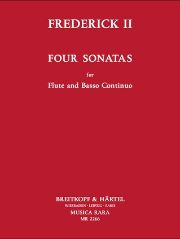From a royal hand
Mary Oleskiewicz presents four sonatas by Frederick II playing the flute as first publications.

The Prussian King Frederick II (1712-1786) published numerous compositions for his instrument. He wrote to his sister Wilhelmine about his works with enthusiasm and humor, and it is also clear from the correspondence that Frederick sometimes received help from court composers such as Carl Heinrich Graun, Johann Joachim Quantz and Johann Friedrich Agricola. During Friedrich's lifetime, his works were systematically recorded by court copyists, but most of the copies were lost. In 1889, the Bach copyist Philipp Spitta published an edition of 25 sonatas by the Prussian king, almost half of which were among his latest works.
Most of Friedrich's sonatas are in four movements in the order slow-fast-slow-fast, as was common for most other Berlin court composers such as Quantz, Benda and Carl Philipp Emanuel Bach. The slow first movements are mostly of an ingratiating nature, richly ornamented, often lyrical and with a rhetorical style. The first movement of the very early Flute Sonata in A minor Sp. 21 contains an instrumental recitative. Friedrich may have intended the cantabile first movement of the C major sonata as an homage to his teacher Johann Joachim Quantz, who had composed the first movement of his own C major sonata in a similar manner. The Sonata in B flat major Sp. 76 even begins with an expansive Largo in B flat minor before reaching B flat major in the second half of the piece. In the slow opening movement of the Sonata in B minor Sp. 83, the sensitive style, such as that of C. Ph. E. Bach composed, for example. Friedrich's compositions reveal a tendency to make the sonatas ever longer and technically more demanding. The fact that the king, who played a repertoire of around 290 concertos and 150 sonatas by Quantz on the transverse flute, must have had extremely virtuoso skills himself is demonstrated by the Sonata in B minor Sp. 83, which, for example, contains very fast passages in the second movement Allegretto with leaps up to the three-note e and f sharp, notated in 32nd notes. The Allegro assai also impresses with its playful triplet configurations.
These four sonatas are appealing compositions in which the Prussian king's inventiveness, sense of style and skill can be seen and heard.
Frederick II the Great: Four Sonatas for Flute and Basso continuo, first edition ed. by Mary Oleskiewicz, score and part, MR 2266, € 29.50, Breitkopf & Härtel, Wiesbaden 2012







